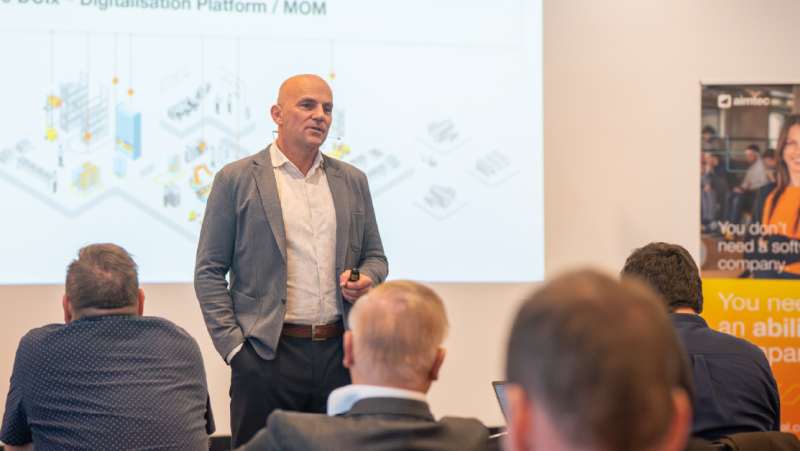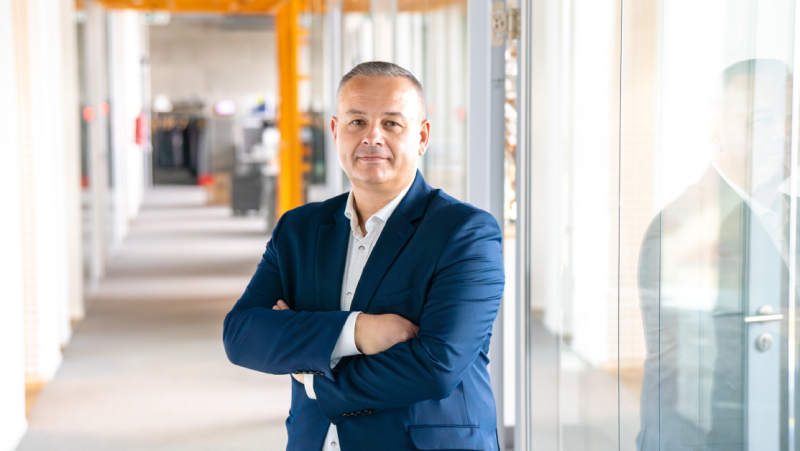Automation diminishes flexibility. Aimtec’s Rostislav Schwob explains how to restore it.
- Digital Factory
- Interview
A full 95% of the firms approached in the Trends in Czech Logistics 2022 study stated that they plan to automate and acquire more modern machinery within five years. Meanwhile, new technologies, sensors and approaches to managing large datasets are being developed constantly. New orders often bring changes to the processes and conditions inside a company. Many interconnections are formed in the midst of all this, which necessitates changing and developing a firm’s overall control logic. How should you approach these demands? Is it even possible to connect it all, manage it digitally from one place and have a single, functional digital world? We asked Rostislav Schwob, Supply Chain Solutions Director at Aimtec.
What sorts of needs and requirements are you encountering among your customers these days?
Recent years have been all about digitalisation. Nearly every machine, tool, robot, conveyor or truck can be connected over wifi or LAN to a computer network and managed and controlled digitally. A new dimension is opening up, wherein you can interconnect everything digitally into a single whole, manage it synchronously and optimise it in real time. I dare say it’s every manager’s dream to immediately learn of any problem that might occur, or better yet know how to predict it so that they can intervene and decide in time. So we’ve been encountering two basic requirements among our customers. They want to connect and control machines and automated equipment and manage them optimally. They’re simultaneously demanding the ability to collect all process and equipment data and know the parameters of desired and undesired states. Then based on this they can seek causes and circumstances and optimise the process further. All in real time.
You use the terms “horizontal integration” and “vertical integration”. What do they mean, and how do they differ?
Acquiring an AMR (Autonomous Mobile Robot), AGV (Automated Guided Vehicle), ASRS (Automated Storage and Retrieval System) or machining centre without integrating them with an ERP is pointless today. But I do have to note I’ve seen fully automated solutions for complementing production in which there wasn’t a single human between the warehouse and the work centre, and the part crates moved completely on their own. But humans entered commands into the control SW manually via a keyboard. That’s why we speak of vertical and horizontal integration.
If we imagine a plant-wide system as a factory’s head – its brain – and connect it with technologies and machines down in the production hall, this is vertical integration, without humans as intermediaries. Things like the production plan, tasks, commands and the instructions for machines and feedback or the data for technologies flow back on their own into the ERP.
Horizontal integration means interconnecting all the subsequent processes, from receipt of materials at the warehouse through various kinds of handling, the management of production, quality, maintenance and final checks on through shipping, and interconnect it all so as to prevent errors, poor quality and downtimes and keep production running with the maximum required performance. This integration means more than just technical interconnection; it’s also an interconnection of processes. If there’s a problem with quality at a work centre, the quality assurance team must be called in instantly. Manufacturing, logistics, maintenance and quality assurance must all work as a single, coordinated team.
How does a digitalisation platform relate to all this, and how can it potentially help?
In the past we received requirements in the spirit of: “We want to connect a machine or equipment with an ERP (e.g. SAP). We don’t want any logic, functions or screens, just the passing on of instructions, tasks, and nothing more.” But it would ultimately turn out that the possibility of setting parameters, conditions and algorithms would be useful, since creating all the rules and conditions directly within an ERP is not always appropriate and flexible enough. That’s why I’m inclined towards the concept of the “Intelligent Layer”, which connects the ERP with all the technologies and people on the shop floor. Since it’s intelligent, it’s able to behave differently in different situations; it’s able to react to both standard and non-standard states. It’s able to connect to machines, automated trucks and handling equipment (VNAs and AGVs), robots, conveyors, sorters, boom gates and also automated sorting and retrieval systems, warehousing systems and the AutoStore, Servus and Ideastorage robotic systems. It connects everything into a single functioning whole. It communicates with information systems, technologies and people. That’s why we call it a platform, and because it controls everything digitally, it’s a digitalisation platform.
What does this “invisible” platform bring the customer? Does it lead to benefits for the customer too, or does it primarily make things easier for suppliers?
Automation in manufacturing and logistics has one pitfall. You lose flexibility. Every solution is partly customised, and changes are complicated. That’s why, if I were choosing a solution, I’d be wanting to regain flexibility. I know that some technologies, such as fully automated warehouses, simply can’t be reshaped, but I would still like to change algorithms, conditions or rules. And if I’m buying a platform, I expect to be able to make these changes quickly and easily with no need for programming. I’d even like to change things myself, without an expert’s intervention.
„It always turns out that no solution is forever, and that expansion, change and improvement are standard requirements in our times. “
Rostislav Schwob, Supply Chain Solutions Director, Aimtec
You lead a logistics division, where for over 20 years you’ve been successfully deploying and developing your own product, DCIx, primarily at companies from the automotive environment. How are you moving towards the above approach?
In the very beginning we deployed the WMS and controlled logistics simply by giving people a mobile terminal. Controlling interconnected technologies in real time was merely a dream. For years now our bets for our application’s development have been placed on a single chip – knowing how to configure and set up system behaviour to precisely fit every process and customer requirement. Today we are benefiting from that skill.
Our Process Builder tool for unlimited system-behaviour configuration is used for controlling technologies and automation equipment. What we’ve had to change is the system’s architecture. We’ve adjusted the “guts” of the application so that we can run it in the cloud. Thanks to this, we can do 24-hour monitoring and are able to provide the customer with maximum service – they don’t have to look after anything. We’re also developing our own abilities, for example in the area of simulations, so we can advise the customer on which organisational variant is the most beneficial. Knowing what to decide before implementation itself is cheaper than breaking and changing things later on. Artificial intelligence and machine learning are other areas we’re engaged in. The goal is to replace humans in the administrative role as well.
Can you give at least a few examples of customers whom you’re helping thanks to these new ideas and approaches?
I personally like the comprehensive projects where crates, pallets and parts move on their own and the job is more than just carrying them from place to place. For example, at DŘEVO TRUST we’re controlling two of this company’s automated stackers, which meet at one shared track before the warehouse aisles. They’re synchronously controlled, so as to keep them from colliding while letting them work simultaneously. Completing this whole are a vacuum handler for moving parts from pallet to pallet and a number of conveyors for the individual movements of readied pallets. A quite interesting job for a distribution centre, with a number of optimisation tasks.
As a second example, I can name the project for auto parts manufacturer BRANO where we control several different technologies – conveyors with crossroads, a depalletiser, fully automated trucks and an ASRS-based fully automated warehouse with a storage depth of 4. We have to know how to manage it all in connection with production, the production plan and the current needs for parts at work centres in the production hall. This project was largely revolutionary for BRANO, from paper to persuading operators in production and operation at the warehouse to the fully automated supplying of production within the whole process, starting with receipt, and ending with the line.
Share article
Top stories from logistics, production and IT.
Subscribe to Aimtec Insights
By registering, you agree to the processing of your personal data by Aimtec as described in the Privacy policy.
Get top stories and articles
from Logistics, Production and IT.
Subscribe to Aimtec Insights
By registering, you agree to the processing of your personal data by Aimtec as described in the Privacy policy.








